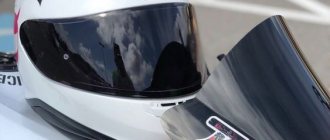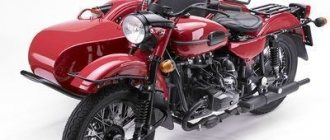Shoei GT-Air motorcycle helmet
I really love simplicity in things - including motorcycle equipment. Some people prefer transformable modulars with Bluetooth and retractable glasses, but I much prefer simple integrals.
I travel at any time of the day or night, and at some point I got tired of carrying a second visor with me. At first I tried to find dark glasses for a helmet, but in the end a couple of years ago I bought a Shark Speed R with retractable glasses. True, it is very well ventilated - even too much, so now I had to squint not from the sun, but from the wind.
Shoei GT Air
The Shoei GT Air motorcycle helmet is a touring integral, quite in the Shoei tradition, of high quality and equipped with a couple of smart technological solutions. In particular, when designing the drop-down glasses, they took special care not to reduce the protective properties of the front part of the helmet.
Over the course of a year and a half of using it, I rode it on a variety of motorcycles, from small naked bikes to large streetfighters, on various touring bikes, cruisers, tourers and sports tourists. We rode it through a 12-hour drive in scorching heat and a nasty late-October icy road mess, and it proved to be a truly versatile helmet, passing all of these tests with flying colors.
Shoei GT Air shell
The outer shell of Shoei helmets, made using AIM technology, consists of glass fibers, organic fibers and polyester resin, creating a durable and lightweight structure. The Shoei GT Air helmet model comes in seven sizes and three shell sizes. Shoei talk a lot about active and passive safety - in particular, that the rider’s comfort and clarity of thought lead to increased attention and correct reactions, thereby preventing accidents (this is passive safety), but if it does happen, then a high-quality helmet should provide the maximum protection (active safety).
Weight
You can immediately feel that it is heavier and larger than my previous Shoei NXR. The shape is sleek and the colored versions look much sportier than the white version. The Shoei GT Air weighs 1467 grams, which is 157 grams heavier than the NXR. However, this is significantly less than many Arai models.
Shoei GT Air
Ventilation Shoei GT Air
One large window at the top, one at the chin and one outlet at the back work well, but not as well as the NXR. This may not be a fair comparison - the NXR ventilates particularly well, and most other helmets are about as ventilated as the GT Air. It probably wasn't that easy to get a good purge, given the built-in goggles. But the valves on the air windows are convenient to open and close even with thick gloves.
Visor
The visibility in the Shoei GT Air is very good, with the pinlock there is no fogging, and the curtain on the chin protects from the cold wind from below. The visor does not struggle to open at high speeds, despite the lack of a clasp, as on some helmets, but opening it for a breath of fresh air is easy and convenient.
The sunvisor, in other words, built-in glasses, is pulled out by moving a simple lever and provides good protection from the bright sun. But personally, I like a normal dark visor much better, and besides, the glasses sometimes fog up despite the declared anti-fog properties. After a couple of minutes the air blows on them and the view improves. Apparently, this is just a property of my body, because I noticed this with other helmets with built-in sanvisors, but I expected more from Shoei.
Removing and installing the visor is somewhat more difficult than on other Shoei. At the same time, you have to apply somewhat excessive, in my opinion, force to the visor, and every time I worry about breaking it. True, for those who are used to the Arai, changing the visor to the GT-Air will be like two fingers on the asphalt, but for those who have driven in other Shoei, like me, it will be unclear why they abandoned what already worked so well.
Shoei GT Air lining
Definitely a touring helmet, not a racing helmet - much softer than most sports helmets. But for some reason, other Shoei, Shark or Arai have a much more comfortable lining, especially on the forehead.
It’s not that the Shoei GT Air is downright uncomfortable, but on long trips in the heat, your head feels worse in it than in the same Shoei NXR.
I regularly go on short long distance trips in it, and take breaks about every two hours. There were no problems with it, the lining absorbs sweat well and wicks it away. Fortunately, I have never used the quick release system (it is needed in case of an accident). But it's better with her than without her.
Shoei GT Air lining
Clasps
A simple and reliable system with two D-shaped buckles works perfectly in any conditions: it is convenient to fasten and unfasten even with frozen fingers, the fastening clasp is easy to feel, and it definitely does not unfasten on its own.
Landing
The Shoei GT Air helmet fits snugly but is easy to take on and off. Shoei helmets fit my head shape perfectly and don't feel too tight or loose.
Noise in Shoei GT Air
I never drive fast or far without earplugs, so don't listen to me on that score. With earplugs, the GT Air is as quiet as any other helmet. When I do go out without them, the noise level is still low and does not interfere with life at all.
Test drive: SHOEI Hornet ADV motorcycle helmet - Introduction to the Adventure class
It's time to talk about everything we tried last season. Motorcycle helmet for adventure tourism - Adventure helmet - what is it and why is it needed? Let's look at the 2021 SHOEI Hornet ADV as an example.
MOTOGONKI.RU, December 19, 2021 - The Adventure helmet is aimed at a motorcyclist who, without hesitation, will turn off the highway into the pampas, in other words, we are talking about a tourenduro
.
I purchased my first helmet of this class in 2008, it was the ARAI Tour-X. True, then the manufacturer positioned it as a helmet for supermoto
. The tourenduro class, as a separate direction, was just gaining its identity. I must admit that I did not use my Tour-X for its intended purpose: the motard did not take root with me, and the helmet was not suitable for riding as a sports tourist, so it lay for many years on a distant shelf in the garage.
The era of big enduros
There were two main shortcomings that did not allow the Tour-X to reveal its potential at that time: the poorly designed visor design and “musicality”. As soon as you raised your head, the stream picked up the “sail” and tried to tear your head away from your neck... and what whistles it made at a speed of over 100...
SHOEI Hornet DS first generation (2010)
SHOEI also had its own helmet of a similar class in its assortment - Hornet DS: awkward, with a small viewing angle and the same “sailing” visor... Hornet had the same childhood diseases as Tour-X, and that’s why it was extremely unpopular in Russia. A lot of time has passed since then, and manufacturers have done a lot of work on bugs. For a new era was dawning - the era of big enduros. The need for this type of motorcycle helmets manifested itself when the market was formed and strengthened, in 2010-2012.
It was SHOEI who realized that this product should be distanced as much as possible from motocross, and indeed from racing in general, because Enduro, Dual Sport and Adventure Touring are three completely different ideas!
SHOEI Hornet ADV debuts at INTERMOT-2014
At INTERMOT-2014, the Japanese company presented a completely redesigned Hornet ADV - a Premium class touring helmet aimed at the most demanding travelers. Since then, the Hornet has been produced almost unchanged.
The Adventure helmet is a hybrid based on the lightweight and reliable design of a motocross helmet, plus the comfort of a road helmet. From the cross-country helmet, the Adventure received advanced protection for the front of the head and a powerful visor; from the integral, it received a visor and a hidden duct ventilation system.
Test drive SHOEI Hornet ADV
What are the features of the Adventure helmet and its differences from a motocross helmet and an integral?
Difference from a motocross helmet
If at the beginning of the production of Adventure-class helmets their design was identical to cross-country prototypes, over time they began to differ, both in shell production technology and design. Just compare the SHOEI Hornet ADV with the VFX-WR to see how the evolution has gone.
Comparison of SHOEI Hornet ADV and SHOEI VFX-WR
The shell of a touring helmet is thicker and smoother. The lower ventilation channel is focused on airflow to the visor, whereas in the cross ventilation channel it is through. In the cross-country model, the ventilation is open, the shell is shaped in such a way that the rubberized straps of the goggles hold tightly during active driving. Accordingly, the noise level of a motocross helmet is simply off the charts, since it is not at all designed for speeds exceeding 100 km/h.
The ADV's internal upholstery materials are designed for long-term contact with the skin of the face and head during a raid, while the upholstery of a motocross helmet requires active but short-term use with frequent washing of the insides.
Test drive SHOEI Hornet ADV
Why do you need a visor - to hide from the sun? The visor helps cross-sport riders and endurists when riding in a group off-road. The “farshmak” flies from under the rear wheel along two trajectories: almost straight (if the hook is insignificant) and along a sinusoid (if the wheel digs deep). Thus, it flies into the face of the rider next behind, mainly from above.
But with a visor, a slight tilt of the head helps to completely cut off the flow of debris!
The developers of the SHOEI Hornet ADV took into account that travelers travel hundreds of kilometers on asphalt, which means at high speeds. The visor is made of hard, thick plastic and is directed at a more aggressive angle of attack (slightly downward), plus it fits tightly to the helmet and does not deform under wind pressure. In addition, it has a number of aerodynamic cutouts, thanks to which the flow does not lift the helmet up, but, on the contrary, presses it down.
Using the VFX-WR as an example, it can be seen that the visor of a cross-country helmet has a larger area, but is quick-release and flexible, easily bending (or breaking) upon hard contact with the ground. Passive safety technologies in off-road racing are aimed at converting direct impacts into sliding ones, since races take place on loose soil or a special area with artificial elements (Hard Enduro and Endurocross), where there is a high probability of getting caught in a fall and getting injured. Magnetic visors are used, which gracefully unfasten the first time you touch the ground, which reduces the risk of cervical spine injuries. But in a touring bike, another risk is either accidents at speed or falls on hard surfaces (stones, tightly compacted, dry clay, asphalt, etc.), so you need to protect your head from penetrating impacts.
Difference from integral
The difference from the highway integral is obvious and lies in the shape of the shell. The purpose of the integral is to provide maximum protection against direct impact and sliding on asphalt while maintaining compactness and low weight. The Adventure helmet is extended forward, the protection of the cheekbones is more actively developed, and there is more “air” in it - buffer space. At the same time, the developers are faced with the task of reducing the noise level as much as possible.
Speed tests of Honda VFR1200X and SHOEI Hornet ADV: 180 km/h - normal flight!
The first part of the SHOEI ADV test took place while driving a Honda Crosstourer VFR1200X. The powerful wind protection of this [mainly road] hiker immediately cut off any hint of whistling and background low-frequency load, without even requiring earplugs.
At first, I was a little worried that history would repeat itself on the Tour-X with the powerful Hornet ADV visor at high speed. But the Crosstourer’s speedometer reads “180 km/h,” and my neck didn’t feel any stress! I rode the VFR1200X at SHOEI for about half a thousand kilometers in a day and have never regretted it.
SHOEI Hornet ADV: D-ring closure
I will add that I have ridden the Crosstouter quite a bit in the past, both in the integral (in tests in 2012) and in the flip-up (later, in 2021 and 2017), and I must say that after all, the level of comfort of the flip-up suited me 100% This bike does not require an integral.
But given that the ADV has a secure D-ring fastener, like all integrals, each time removing the helmet takes time. This is enough time to not have time to stop and answer the phone. Anyway, turn off that phone... you're on the road. Off-line.
For its intended purpose
What is the SHOEI Hornet ADV Adventure helmet like for a combined on-road and off-road trip? To do this, I switched to a Honda CRF1000L Africa Twin Advenure Sports - a motorcycle that is ready to go all out, less powerful, but still quite fast, with a much higher seating position and different aerodynamics. Its ceiling is “only” 210 km/h.
Go?
The very first test of SHOEI is a crash test in a banal street accident! The collision with the car took place at low speed, but I still had to do a small somersault and land on the asphalt. Thanks to the Leatt Body Vest with 3DF and the turtle, the contact went without consequences, the only thing I was worried about was the helmet visor. A thorough inspection showed that there was no trace of the incident left on SHOEI.
The helmet went with me to Finland, paired with a flip-up, and was regularly changed during the 2,500-kilometer run. In the wilds of Vyborg and the picturesque Rautyarvi quarry, the SHOEI ADV was tested for strength twice more, maintaining its original attractiveness and appearance. The only thing is that there are spots on the visor from chips - places of contact with stones. But not a single one got into the visor the entire time!
And trees grow on the rocks!!! Test Honda CRF1000L Africa Twin Adventure Sports in Finland
Already during the test drive, a pleasant feature of the SHOEI visor was revealed, which I had not thought about before. Since modern touring bikes are equipped with good wind protection, less headwind enters the helmet: this is how developers strive to increase comfort and reduce physical stress on the pilot’s shoulders and neck. But at the same time, the degree of airflow decreases. In the rain, when driving at low speeds, the SHOEI visor fulfilled its purpose - only a few small splashes got onto the visor, and large drops - all were eliminated! At speeds over 120 km/h, the Hornet ADV's aerodynamics are almost integral: water droplets do not linger on the visor, sliding to the sides along the glass. You just have to tilt your head forward a little, and the visor begins to play the role of additional weather protection, cutting off water dust.
Test drive SHOEI Hornet ADV
The SHOEI ADV visor is designed from the ground up for Pinlock use and I have never had any fogging issues on the road.
But pulling a fallen motorcycle in any closed helmet is agony. Even a very well ventilated SHOEI ADV begins to fog up during vigorous physical activity. That’s why an Adventure helmet is not suitable for sports use—you need a cross helmet. The additional weight of the Premium-class filling will also have an impact on sports - an extra 300 g: SHOEI Hornet ADV weighs about 1550 g, and its cross-country brother SHOEI VFX-W - 1250 g.
And finally, the myth about the too large dimensions of Adventure helmets is safely dispelled: the SHOEI Hornet ADV easily fits into the GIVI Maxia case along with the flip-up. Have a nice trip!
Test drive SHOEI Hornet ADV
Total
Now I have helmets for any occasion, three of them: flip-up with a headset for long trips and everyday travel; integral for track tests; as well as SHOEI Hornet ADV for off-road excursions. The Adventure helmet is close to the integral helmet, but it has much better visibility and passive protection. At the same time, it is not relevant for naked bikes, sport bikes and sports tourists, since it is heavier than the integral and larger in size. This is “the second helmet in the family.” Some features make it indispensable on long journeys where the average speed is below 100 km/h and there is a high chance of falling over on uneven surfaces - the safety level of the SHOEI Hornet ADV is higher than that of any flip-up. There are no moving parts or mechanisms that could become unusable as a result of falls.
And yet, if there is a financial opportunity, I would recommend the option of a new generation of helmets for Adventure tourism - this is the Schuberth E1
, the first Adventure helmet of the flip-up type, that is, with a folding visor. But we'll talk about it next season.
We thank the official distributor of SHOEI in Russia for providing the SHOEI Hornet ADV motorcycle helmet for testing. You can get acquainted with its technical characteristics and current price on the official website bikeland.ru or by calling 8-800-333-6653.










